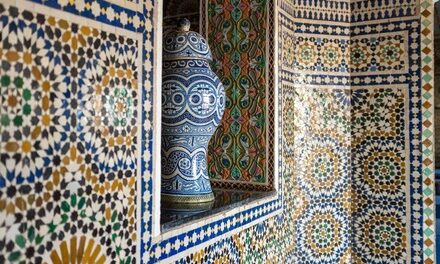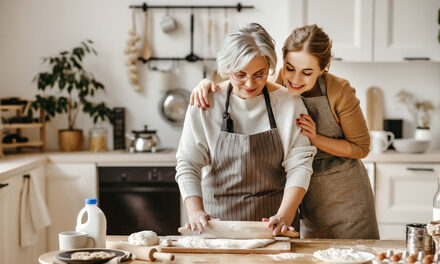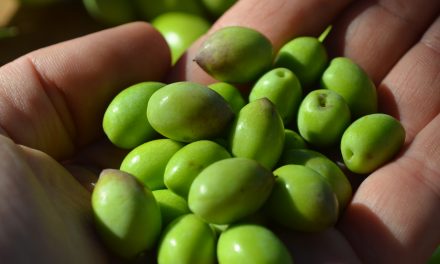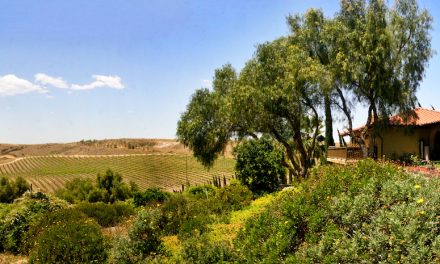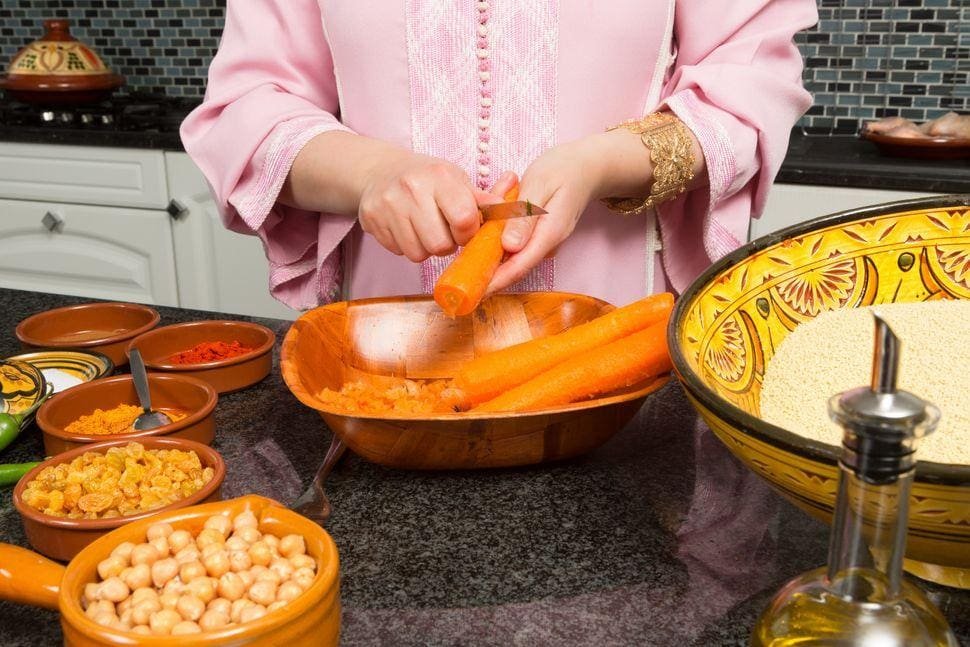
We don’t only love eating the food, but we also love being close to the preparation of what provides us with sustenance. In my household, I know that my kitchen is so much more than just the room that produces the food. It is, in fact, the place that acts as the gathering spot. The engine room for the entire house. It shows how much humans naturally gravitate towards being around food.
Throughout time. kitchens were not always been used this way. The ‘cookhouse’ started out as no more than a hole in the ground where a fire was lit. Usually some distance from where the main dwelling would have been located. Locating it away from the main house minimized smoke from the fire overwhelming the living quarters. More importantly, it ensured that the fire could be maintain alleviating concerns that about flames getting out of control and curing everything down. This problem eventually led to the invention of the hearth, which encircled the fire, containing it to one spot.
In the Arabian Peninsula, nomadic tribes lived in deserts and their ‘kitchens’ were always temporary. The main cooking technique was to dig a hole and get a fire going in it. As the embers died down, meat was placed over the embers, covered and then buried with sand. As you can imagine this form of cooking produces the most tender of meat dishes, known as zarb. Traveling tribes would cross each other’s paths, giving rise to customs that built social capital through being gracious and courteous to strangers. Arabs like to show their standing in society through the spread they can lay on for their guests.
In Ancient Egypt, clay ovens were used along with cooking pots, pans, clay pots and plates. As kitchens began to modernize, cooking utensils were invented for different uses. The ancient Greeks cooked using a spit over a large fire, and also utilized clay domed ovens. They tended to make their kitchens separate structures at the back of the house. And they also cooked meat and vegetables buried in a hole over hot coals; a similar method to the Arab nomads. Another similarity to the nomads is that ancient Greeks also ate with their hands or bread.
Bread became a universal food due to its nutritional characteristics, and was adopted by most cooking cultures around the world. I’m talking bread made with whole grain flour of course. Bedouin tribes in the desert today will make a dough and handle it pretty much like a pizza pie maker does, stretching it out by throwing it. Then they bake it over a convex piece of metal placed over a fire. In the old days they would bake the bread right on the hot embers of the fire. Saj or shrak in the name given to the bread cooked over the metal surface. Taboon is bread cooked directly on hot embers or stones.
In the area of the Levant, the peasants and farmers were utilizing communal domed clay or stone ovens for their cooking. Large families lived and worked together in villages alongside other families; intermarring, and socializing together, through food, with cooking playing an important role in everyday life. Prepared at home, food in need of cooking was taken to the public oven. As the Roman Empire enveloped these villages, they were influenced by the latest cooking ‘technologies’.
In Roman times, kitchens became incorporated into the house with ovens and open fireplaces. Interestingly, the Romans also invented ways for the fireplace to heat the entire house using underfloor pipes that would transfer hot air. This method was also used to heat water for baths. The size of a kitchen to the Romans had a direct correlation to socioeconomic status. I would argue much like today!
While all these changes were taking place in how people cooked around the world, changes in attitudes, and customs were also taking place. Lots of the customs we see today are a carryover from the time of our ancestors. They have become rules that we follow in our everyday lives in order to live together in harmony. These customs, rules, and etiquette developed out of how we prepared food, lived our lives, and learned to coexist. We now take for granted the social norms that have developed around our food eating habits. And we often look askance at what people in other cultures do, and don’t do.
In the Arab world a lot of eating takes place with the hands, more specifically the right hand. It is seen as very rude, and just not done to eat with your left hand, including if you are left handed. The left hand is seen as being unclean, and maybe before running water, it especially was. However, if you grow up in Chile, then eating with either hand is deemed disrespectful, and rude. In China, you have to leave a little food on your plate to show that your host fed you enough. But in India you must clean your plate in order not to be seen as rude. In South Korea, you must wait for the oldest person to start eating before beginning the meal yourself. And then you must not out pace that person, and eat too quickly. Following local customs shows good intentions to one another, and is a form of coming together as one.
Establishing respect and trust is extremely important in the Arab world, and formal occasions will have a social aspect to them. This gives those present time to earn the esteem of each other. Respect and family honor is huge in Arab society, and family is revered above all else. Showing generosity is also a very important tenant in Arab culture, with hospitality bestowed liberally on friends as well as strangers. Often these kindnesses are shown through occasions where food is shared, and eaten together. This custom is not just practiced by those who can afford it either. The less well off, and poor people are also very giving of what they have to others as an expression of honor.
As these acts of goodwill are bestowed upon each other, we notice that the overwhelming majority of them come from our kitchens, and the foods we prepare. We are social creatures who gravitate towards each other, and show our love and respect for each other through eating together. As we feel that love, which comes from the heart, we recognize that that heart is at the center of every home.
Zarb Recipe (Modern Take)
Ingredients and Prep
- 5lb bone-in leg of lamb
- 2 heads of garlic
- 6 carrots
- 3 onions
- 4 tbsp olive oil
- 1 tbsp seven spices
- 1 tsp salt
- ½ tsp pepper
- Preheat the oven to 450ºF (230ºC)
- Cut carrots into thirds, and onions into quarters and place in a bowl.
- Add 3 tbsp of olive oil, along with the heads of garlic, and mix them with the vegetables.
- Pour the vegetables in the bottom of a Dutch oven.
- Rub the remaining tablespoon of oil over the leg of lamb. Rub the seven spices, salt and pepper into the meat, covering it as well as possible.
- Place the meat on top of the vegetables, and cover the Dutch oven with its cover.
- Place it in the preheated oven for an hour, then turn the heat down to 275ºF (135ºC). Continue to cook for another hour, then turn heat down to 200ºF(90ºC) and cook for two more hours.
- Remove from the oven and allow the meat to rest for 30 minutes without opening the Dutch oven.
- Alternatively cook in a slow cooker for eight hours.
Mansaf
Another meal that is a traditional food served at occasions when people come together is mansaf—a traditional Jordanian dish that is served at any big gathering, from weddings to funerals. Mansaf is definitely a unique dish in so many ways, from its ingredients to the way it tastes.
The history of this dish is one that goes back a long way and was a meal eaten by bedouin tribes. Originally it was a dish made with either camel or lamb meat, served with a very thin flat bread and a meat broth and clarified butter. It has now evolved to include rice, and a yogurt sauce, flavored and made with jameed, a dehydrated salty yogurt, that is reconstituted with water.
Ingredients and Prep
Meat
- 2 lbs Lamb Meat cut into chunks (including bones)
- 6 cups Water
- 2 crystals Gum Arabic
- 4 Cloves whole
- 4 Cardamom pods
- 1 Cinnamon Stick
- 13 Allspice berries
- 1 Bay Leaf
- Put the lamb in 6 cups of water, bring to a boil and add the spices.
- When the water comes to a boil turn down to a slow simmer.
- Cook for 2 hours or until the meat is tender. Add more boiling water if necessary.
- Once the meat is done, pour through a sieve and preserve the water. Set the meat aside on a plate for later
Rice
- 2 cups Rice
- 4 cups Water
- 1½ tsp Salt
- Pinch of Saffron
- In a pot, put 2 cups rice, 4 cups water, 1½ tsp salt and a pinch of saffron.
- Bring to a boil, then reduce to a simmer and cook until all the water has gone.
Toppings
- 4 tbsp Almonds blanched and chopped
- ¼ cup Parsley chopped
For the Laban Sauce
- 1 Laban Jameed
- 4 cups WaterWrap the laban in a cloth and break into pieces with a hammer.
- Place the laban and 4 cups of water in a food processor and process until laban has dissolved.
- Pour laban into a bowl through a sieve, set aside.
- Pour the laban into the meat water, and put back on the heat. Bring to a boil.
- Add the lamb chunks to the sauce (leaving out the spices).
Bread Base
- 2 loaves shrak or tortillas
- Bringing It All Together
- Toast your almonds in a frying pan with a little olive oil.
- Tear bread into little pieces on a plate as a base for the meal.
- Ladle some of the sauce over the bread on the plate.
- Spread the rice over the bread.
- Ladle more sauce over the rice.
- Place the lamb chunks on top of the rice.
- Ladle more sauce over the top.
- Sprinkle toasted almonds and parsley over the entire dish.
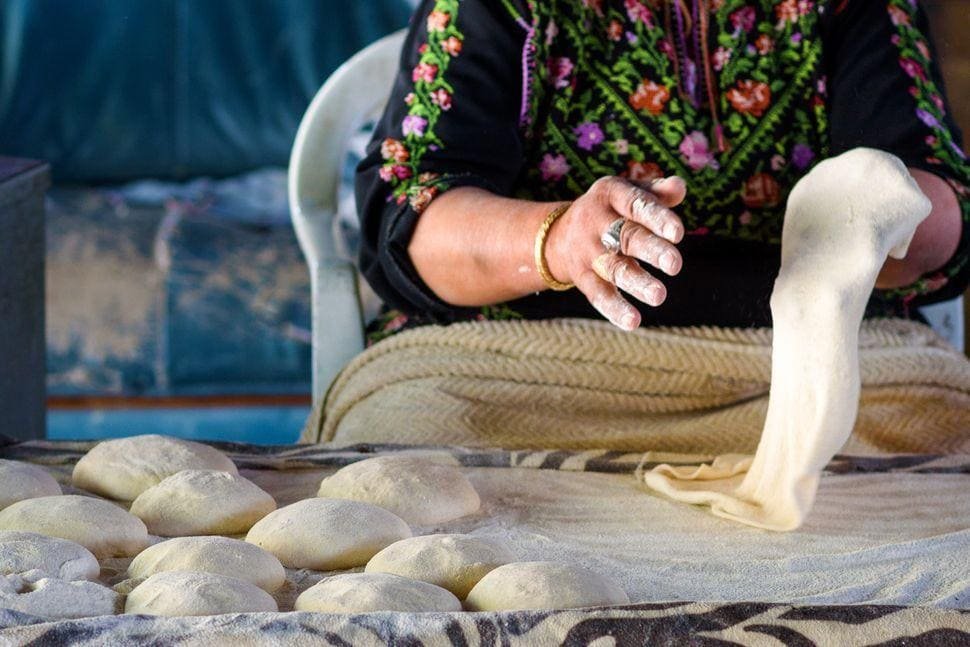
Ingredients and Prep
Saj Bread
- 4 cups flour
- 2 tsp yeast
- 1 tbsp sugar
- ½ tsp salt
- 1 tbsp olive oil
- 1½ water
- Add the flour, yeast, sugar and salt to a large bowl, stir to mix, and make a well in the middle.
- Pour in the olive oil and water, and mix until a dough forms.
- If it is too wet add some extra flour, and if too dry, add a little more water.
Knead for ten minutes, cover and let rise until twice its size. - Divide the dough equally, and roll into balls, then cover and allow to sit for 15 minutes.
- Roll out the dough balls on a lightly floured surface, until the dough is extremely thin. Think crepe thin. You can bake over a convex surface over an open flame or you can bake on your stovetop on a griddle. This bread cooks very quickly, so keep a close eye on it!
Taboon Bread
With a combination of smell, warmth, crunch, and softness all hitting your senses at once in a way that is hard to replicate with any other food, this bread is a winner!
- 4 cups Bread Flour
- 1 tbsp Salt
- 2¼ tsp Yeast instant
- 2 tbsp Olive Oil
- 1¾ cup Water warm
PREP TIME: 10 minutes
COOK TIME: 7 minutes
TOTAL TIME: 17 minutes
Servings: 12 loaves
- Mix the flour, salt, and instant yeast in a bowl.
- Add the olive oil and water, mix until dough emerges.
- Knead dough for a few minutes.
- Cover and set aside until dough is double in size.
- Punch down and knead for a few minutes.
- Preheat oven to 400°F (200°C).
- Cover and set aside until double in size.
- Cut into 12 even pieces.
- Sprinkle flour on a surface and roll out dough into round loaves.
- If using stones in a pan, once oven is up to temperature, place the dough loaves one at a time until cooked (5-7 minutes).
- Remove and cool on a rack.
Chef Tariq is a leading resource for Middle Eastern recipes. Raised in Jordan to a Michigan Mother and a Palestinian Father, Taraq was influenced by his Sitti and his love for Middle Eastern food. He shares his favorite recipes for others to experience and recreate in their own kitchen. Visit Chef Tariq in his kitchen today!





